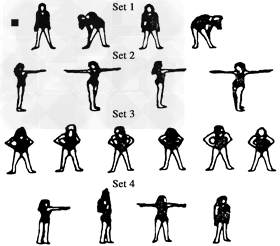阅读理解。
Before any period of exercise it is well worth spending two or three minutes warming up with a
series of simple stretching exercises.This not only helps your joints(关节) to move easily but also
prepares all your muscle groups for more energetic activity.It is rather like a cat stretching itself
before it springs into action.Here are four movements to do in an easy and unhurried way,gently
stretching each action without forcing it.Repeat each movement ten times,breathing normally
throughout.
I.Standing with your feet apart,push both arms out straight in front of you,fingertips touching.Raise
them above your head,then down to the sides pushing each arm backwards at the same time.
II.Standing with your feet apart and hands on hips(臀部).Tip your head back and look straight up
to the ceiling.Roll your head round slowly to face the right,then the floor,and finally up at the ceiling
again.Repeat in the other direction.
III.Standing with your feet apart and hands on your sides,lean first to the right and then to the left,
sliding the hand down the side of the leg.
IV.Standing feet apart and arms out straight in front,with your eyes fixed on your right hands,swing
your right arm round to the right,keeping it straight,as far as it will go.Return it to the front and repeat
with the left arm.

1.Why should you do these exercises?
A.To strengthen muscles.
B.To stretch joints.
C.To prepare for physical activity.
D.To develop control of movement.
2.How should these exercises be carried out ?
A.With pauses,taking 10 breaths between each one.
B.Continuously for two or three minutes.
C.Steadily and slowly,breathing calmly.
D.As energetically as possible
3.The first set of pictures shows you how to do exercise______.
A.I
B.II
C.III
D.IV